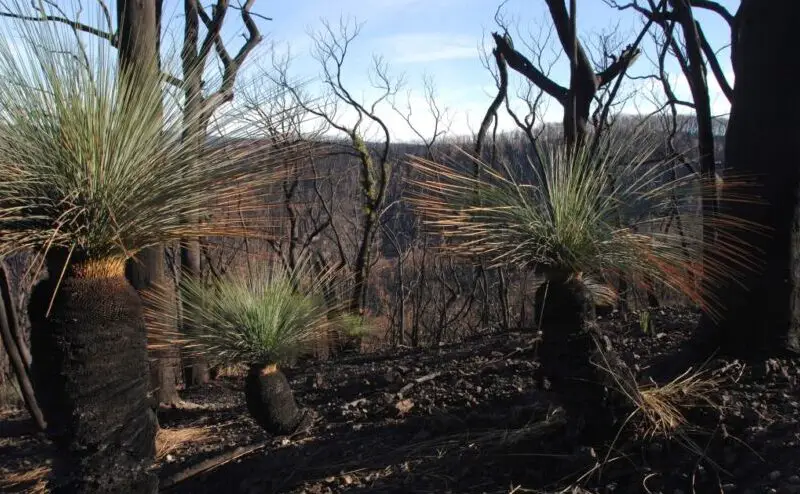Fires are considered catastrophic, and are rightly viewed with outrage and concern. In nature and in certain ecosystems, however, they are indispensable for the maintenance of rather special plant species.
Contents
What is a pyrophytic plant?
A pyrophytic (or pyrophilous) plant is a plant that needs fire to reproduce, renew itself and for the species to survive.
Over the millennia, these plants, which are subjected to frequent fires of natural origin, have developed strategies to survive. These fires, which are always superficial and rapid, have brought about some changes in the plants: they have developed tougher tissues, very deep roots, and fruits that only release their seeds under intense heat.
Passive pyrophytic plants
Try to burn a cork… What’s going on? Nothing or almost nothing. The cork is consumed very slowly. Thanks to its bark, the tree (Quercus suber) resists well to fires, flames and heat strokes. Cork is also used as insulation against heat and cold. The niaouli (Melaleuca quinquenervia) very common in New Caledonia and the giant sequoia (Sequoiadendron giganteum) also have thick bark that protects them from flames.
Active pyrophytic plants
Their strategy is totally different. One could almost call them arsonists, because they set themselves on fire to live better and prevent other plants from threatening their hegemony. This is the case of eucalyptus trees, which produce flammable vapors to make a clean space around them. A way of reigning without sharing.
This is the case of eucalyptus trees that produce highly flammable vapors. Fire allows them to make a clean sweep to conquer the surface and ensure their hegemony.
Other plants do not have this pyromaniac character, but they absolutely need fire to ensure their natural descent. It is the case of a very common plant in our country, the Callistemon. Its red flowers in the shape of pins earned it the nickname of bottle rinser. On this shrub, the seeds are contained in small logs glued to the branches. If a fire passes by, the logs burst and hundreds of thousands of seeds go into the wild.
5 plants that grow back after fire
Marin Pine
The marin pine (Pinus pineaster) is part of the vast Pinaceae family. The genus Pinus includes about 120 species of evergreen trees or shrubs. The maritime pine grows very fast and is cone-shaped in its early stages and then takes on an attractive rounded shape. As an adult, it can reach a height of 20 meters.
It is native to southwestern Europe and the Mediterranean regions where it grows on sandy or even stony ground. In the Landes region, it is used for its ability to fix sand but also for its timber, and in the fields of papermaking and carpentry. Maritime pine is remarkable for its reddish-brown bark that cracks as it grows. It can be used as mulch in bedding, especially at the base of plants that prefer acidic soil. The 10 to 25 cm long grey-green needles are grouped in pairs.
Cork oak
The cork oak, Quecus suber is a species found in France around the Mediterranean and in the southwest. Belonging to the Fagaceae family, this evergreen tree lives about 300 years, and is found on moors, natural wood, scrub, at low altitude, mixed with holm oak, maritime pine, and pedunculate oak. Quercus suber produces natural cork, for which it is exploited.
Eucalyptus
Native to Australia, Eucalyptus is present in all tropical, subtropical and temperate regions, as well as on the Mediterranean rim where it has become naturalized. Very demanding in water it prevents the growth of nearby native plants, a defect that very quickly becomes a quality because it is very useful for drying out swampy areas.
This species produces highly flammable vapors. The fire allows them to make clean room to be able to conquer the surface and ensure their hegemony.
Proteas
Proteas come from the proteaceae family, one of the oldest families in the world.
The plants of this family are native to Australia and South Africa. In South Africa, proteas, leucospermums and leucadendrons are mainly found, while in Australia, more plants belonging to the genera banksias, telopeas and many strikes are found.
The proteas from South Africa flower in spring and autumn, while the protaceae from Australia can flower in winter, spring and autumn.
Sequoias
The giant redwood (Sequoiadendron giganteum) is an evergreen tree native to the mountain forests of California. There is only one species in the genus, but there are a few varieties, such as ‘Glaucum’ with its beautiful bluish foliage or ‘Pendulum’ with its strange silhouette and drooping branches resembling curtain bangs.
The giant redwood should not be confused with the classic redwood because although it is also part of the Taxodiaceae family, it differs in many ways. Conical and slender, giant redwoods have narrow, triangular leaves and very thick, cracked, reddish-brown bark. This tree of exceptional growth can reach a height of almost 80 meters! It produces cones that will take two full years to ripen and produce seeds. They also need a flaming element to release their seeds.
How much time for plants to grow back after fire?
At first, it is the brush that grows, rather quickly. In a few months, we won’t really see that there was a fire. For the pines, it is obviously longer. It’s counted in decades, the time it takes for the tree to grow.
Summary
Fire can be beneficial. Some plant species even need fire. It selects the species of vegetation. The Mediterranean ecosystem has adapted:
Some coniferous trees have developed seeds that need the passage of fire to start growing, other plants will proceed by rejection, i.e. they remain alive underground after the passage of fire and then start to grow again. To a certain extent, fire allows vegetation to regenerate.









